- Home >
- OKinawa Rail >
- History of Okinawa Rail
The Okinawa Rail
History of the Okinawa Rail
This page introduces the history of the Okinawa Rail.
It was revealed after the description in 1981 that there were mountain workers who already knew Okinawa Rail even before it was identified as a new species. It used to be called "Agachi (hasty)" or "Yamadui (mountain bird)".
There were also cases where bird watchers collected their feathers or made recordings or took photographs in the past.
Once they were described as a new species, they became very famous and became a symbolic bird of Okinawa.
Chronological table of Okinawa Rail
- 1964: Calls were recorded in Mt. Nishime by a bird recordist Tsuruhiko Kabaya.
- 1973: A bird watcher Yutaka Otsuka found a dead body in Mt. Yonaha. Its feathers were preserved as an unidentified bird.
- 1975: A photographer Tomoharu Gima took a photograph of an adult. It was preserved as an unidentified species.
A researcher of the Yamashina Institute for Ornithology gets news about a flightless bird. - 1978-80: A researcher of the Yamashina Institute for Ornithology saw an unidentified rail in Mt. Yonaha.
- 1981: An adult and an immature were captured successfully by a team of researchers from the Yamashina Instutute for Ornithology. It was described and named as a new species Rallus okinawae.
It was declared a natural treasure of Okinawa Prefecture.
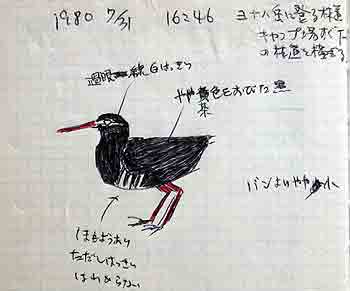
A sketch dran when it was seen before the capture
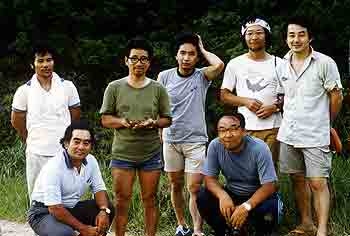
The Okinawa Rail capture team. Mano T. is the third from the left, and Ozaki K. is in the far right.
(photo courtesy of Abe Naoya)
- 1982: Declared as Special Bird Species (Environmental Agency)
Declared as National Natural Treasure (Agency for Cultural Affairs) - 1983: Distribution and status of the Okinawa Rail was studied by Environment Agency (Special Bird Species Study).
- 1984: A nest of Okinawa rail was discovered for the first time.
- 1985-6: Environment Agency investigated the population size and estimated it to be approximately 1800. (Special Bird Species Study)
- 1991: Declared as an endangered species in the red data book of Environmental Agency.
- 1993: Specified as Endangered Species of Wild Fauna and Flora.
Harato T. and Ozaki K. indicated that the southern limit of distribution is moving northwards. (Journal of the Yamashina Institute for Ornithology) - 1995: A symposium on Okinawa Rail was held in Ginowan City, Okinawa Prefecture by the Yamashina Institute for Ornithology.
- 2000: Okinawa Prefecture began eradication project of Javan Mongoose.
- 2001: Specified as endangered species in the Red Data Book of Asian bird species by BirdLife International.
It was revealed by the investigations by the Yamashina Institute for Ornithology and Okinawa Prefecture that the southern limit of Okinawa Rail distribution has moved approximately 10km northward in the preceding 15 years. The population was estimated to be about 1220. - 2002: Ministry of the Environment began eradication project of mongoose.
- Specified as critically endangered in the Red Data Book of the Ministry of the Environment.
- 2003: It was indicated by a study by the Yamashina Institute for Ornithology that the southern limit of distribution has moved further northward in the eastern region.
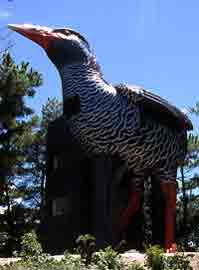
Large statues of Okinawa Rail; a statue with an observatory at Hedomisaki.
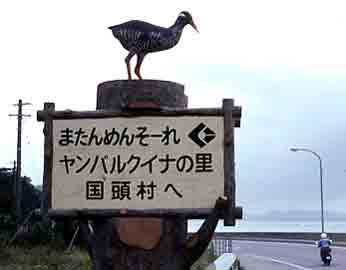
A sign post at the exit of Kunigami Village.
What is Type Specimen?
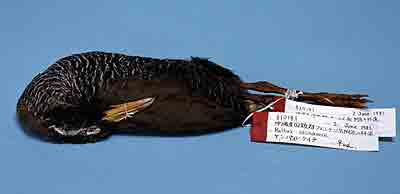
The type specimen of Okinawa rail owned by the Yamashina Institute for Ornithology
When a new species is described (declared as a new species by describing its characteristics and providing a name), a specimen on which the description was based on is required to be specified as the "type specimen". By specifying the type specimen it prevents confusion of names even when their classifications are doubted or changed in later research. When type specimens didn't exist in the old days new species were described only by figures and writings, thus there were often confusions of scientific names. The museums and research institutes that preserve type specimens are responsible for their management under an international agreement among zoologists.

